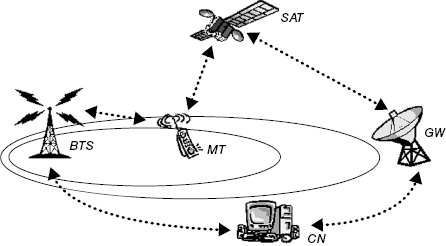CHAPTER FOURTEENLand–Satellite Communication Links
14.1. Objective
The Space Age started on October 4, 1957, when the first artificial satellite, Sputnik 1, was placed in orbit by the Soviet Union. Before October 1957, the term satellite referred to essentially a small body that revolved around a larger astronomical object. Thus, all the moons circling the planets of the solar system were called satellites. Today, these bodies are specifically called natural satellites, and any artificial object that revolves around a larger astronomical object along the elliptical or circular orbits is called an artificial satellite.
The main task of an artificial satellite is to allow stable wireless communication among users located over the Earth [1, 2]. During the last four decades, satellites have been used for wireless communication, weather forecasting, navigation, military observation, and other purposes. In this book, as was mentioned in Chapter 1, we deal only with the aspects of radio communication between various terminals, personal, stationary or moving, portable telephone or ground-based facilities, which will secure a satisfactory quality of service for each subscriber located within such a channel (see Fig. 14.1).

More than 40 years ago, J.R. Pierce and R. Kompfner [1, 2], discussed a number of alternatives, problems, and potential ...
Get Radio Propagation and Adaptive Antennas for Wireless Communication Networks, 2nd Edition now with the O’Reilly learning platform.
O’Reilly members experience books, live events, courses curated by job role, and more from O’Reilly and nearly 200 top publishers.

